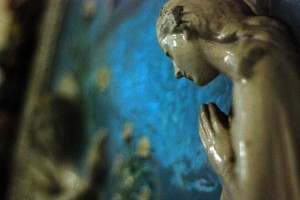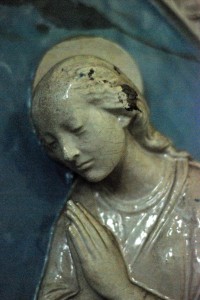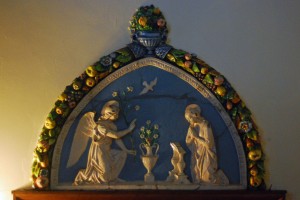The Somerville Annunciation is a 19th century Italian terracotta relief derived from the Annunciation lunette in the Ospedale degli Innocenti or ‘Foundlings’ Hospital’, Florence by Andrea Della Robbia (1435-1525).
The annunciation (Luke 1:26-38) is a common subject in Christian art. The Somerville Annunciation depicts the Angel Gabriel blessing Mary. The other principal symbols being the ‘annunciation lilies’ representing purity, and the dove representing the Holy Spirit.
Somerville College Chapel’s sculpture of the annunciation has an interesting history. When E.G. Kemp originally, and anonymously, offered to fund a religious building at Somerville in 1932, she wanted it to house ‘a wonderful work of art – the annunciation by Della Robbia.’ This was to be placed in a room in the building that had bookshelves and comfortable chairs where students could discuss their plans for charitable and religious works abroad. As part of the negotiations on the terms of the donation, Kemp’s wish to display the ceramic (and her vision for an informal meeting room in addition to a room for prayer) was not granted, and the sculpture remained above her fireplace in her flat in London until her death on Christmas Day, 1939.
In her will, Kemp (a wealthy art collector who, in addition to being among the first students to enroll at Somerville, later studied Fine Art at the Slade School) bequeathed her significant collection of Western and Eastern Art to the Ashmolean Museum; all of it save the Annunciation, which was offered to Somerville. In early 1940 the Chapel’s architect Courtney Theobold removed the ceramic from Kemp’s home and placed it above the north door in the Chapel (which is used as the fire escape today). He noted at the time that it was badly damaged and the terracotta was reconditioned at the Ashmolean museum.
The subject of the annunciation – the divine mission of a woman, Mary – was of great personal significance to Kemp. Kemp was a Baptist with strong feelings about the importance of women in Christianity. She saw the annunciation as representative of the importance of women’s role in spreading God’s message. Her last book, Mary, with her son, Jesus (1930) is given over to an exploration of the life of Mary; her earlier work on women Baptist missionaries, There followed Him, Women (1927), also stresses the importance of women. In it she writes that ‘Woman must all through the ages and throughout the world be the Christ-bearer to all humanity, and first and foremost to her sisters… In the middle of last century the position of woman was contemptible in most countries and the petty conventions of society made it difficult for her to use many of those high qualities and gifts which she possessed.’
The provenance of the Somerville Annunciation before Kemp’s ownership is currently unknown but it has been verified by a leading expert as a 19th century piece. Examples of Andrea Della Robbia’s work (whose workshop became inherited by successive generations) can be found in the Ashmolean ceramics gallery along with other derivative, later ‘school of Della Robbia’ pieces. A cast of the Annunciation in the Ospedale degli Innocenti on which the Somerville Annunciation is based can be found in the cast gallery of the Victoria and Albert Museum.



